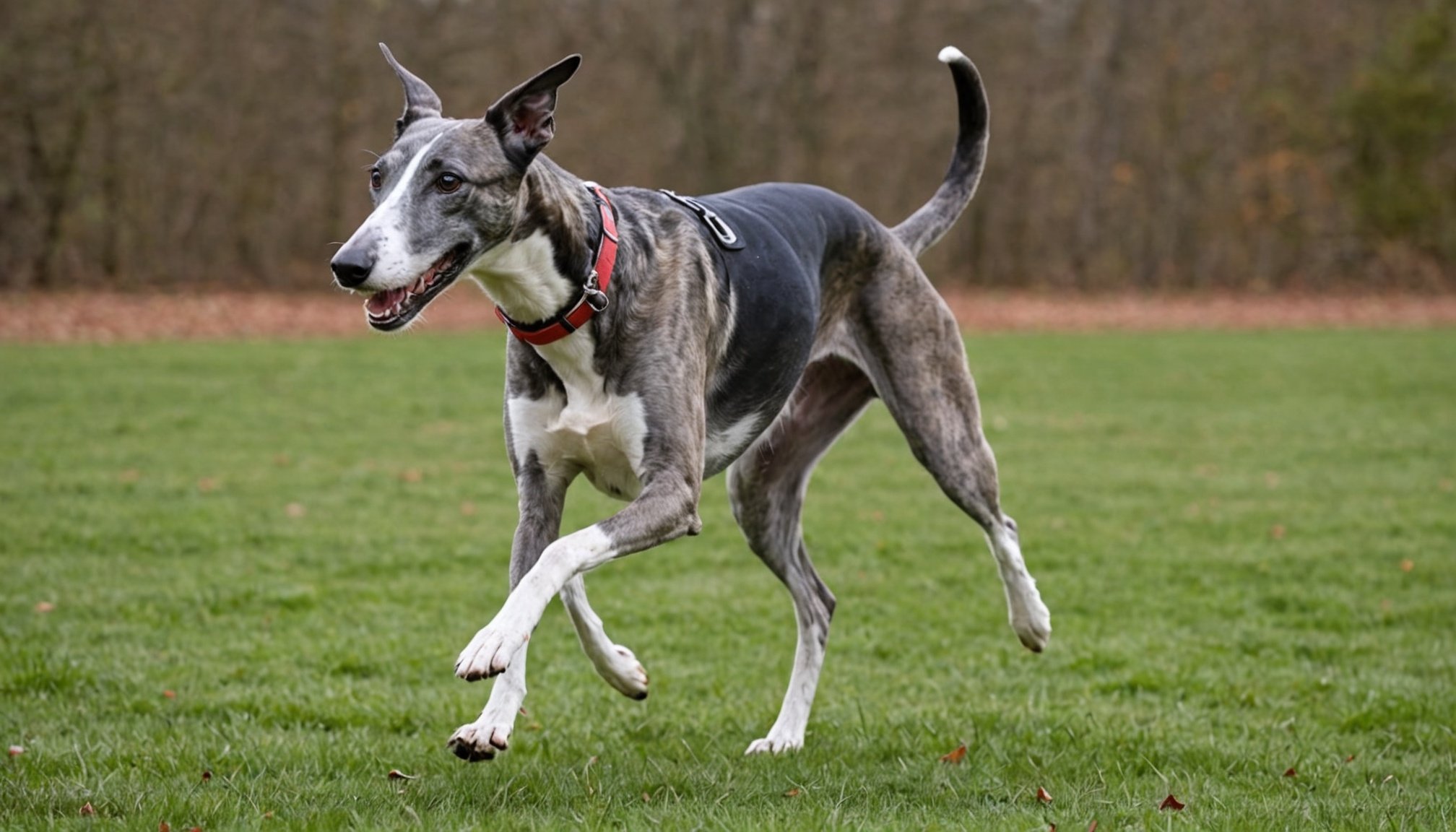Understanding Greyhound Behavior
Understanding greyhound behavior is crucial for effective training. This breed is known for its unique characteristics, including a gentle temperament, high intelligence, and significant prey drive. These traits shape how greyhounds interact with their environment and can influence training strategies considerably.
Common behavioral traits in greyhounds include a calm demeanor and a tendency to be reserved. Despite their racing heritage, they’re often content with sofa lounging and short bursts of activity. However, their prey drive is a significant behavior aspect—a deeply ingrained trait due to their history as sighthounds. This drive means they may chase small animals instinctively, which must be considered during training.
Additional reading : Early indicators of hip dysplasia in young labrador retrievers: what every owner should know
Training methods must accommodate these breed characteristics. Positive reinforcement is often effective, as greyhounds respond well to rewards and gentle guidance. Understanding their dog psychology is key to aligning training methods with their natural inclinations.
It’s essential also to consider the impact of the prey drive in training. Strategies should include controlled environments to manage this instinct safely, promoting discipline while considering the greyhound’s innate tendencies. By aligning training with these behaviors, owners can ensure more successful and enjoyable experiences for both the dog and themselves.
Also to see : Ultimate guide to long-haired chihuahua grooming: prevent matting with these expert tips!
Preparing for Recall Training in Open Spaces
When embarking on recall training in open spaces, selecting the ideal location is crucial. Look for areas that are spacious, away from heavy traffic, and have minimal distractions. Parks or fields are often perfect, as they provide the expanse needed for your dog to safely roam and return.
Equipping yourself with the right tools ensures the effectiveness of your outdoor exercises. Essential training gear includes a long leash, which gives your dog freedom while maintaining control. Treats or a favourite toy can act as rewards, reinforcing the recall command. A clicker can also be useful for marking successful recalls.
Safety is paramount when conducting recall training in open environments. Always assess the area for potential hazards, such as toxic plants or aggressive wildlife. Consider the local weather conditions; too hot or too cold weather can affect your dog’s performance and well-being. Moreover, ensure your dog is wearing a collar with identification and is microchipped, in case they get lost during training.
By carefully considering the training environment and preparing adequately, recall training sessions can become enjoyable and successful experiences for both you and your dog.
Step-by-Step Techniques for Improving Recall
Proper recall training is essential for ensuring your greyhound responds reliably to your commands. Implementing recall techniques effectively can enhance obedience and safety. Here’s how to succeed with this:
Establishing a Strong Foundation
Before starting recall exercises, focus on obedience training by teaching basic commands like ‘sit’ and ‘stay.’ Building trust is crucial, as a strong bond with your greyhound will foster cooperation and eagerness to learn.
Introducing Recall Exercises
Begin recall exercises in a secure, open space where your greyhound feels comfortable. Integrate playful activities such as fetch or hide and seek to keep your pet engaged. This approach not only makes training enjoyable but also reinforces desired behaviour.
Utilizing Positive Reinforcement
Incorporating positive reinforcement is vital for successful recall training. Use rewards such as tasty treats or verbal praise when your greyhound responds correctly. Consistent encouragement provides motivation, leading to improved recall over time.
By following these training steps, you’ll establish a solid obedience training routine, bolstering your greyhound’s recall ability while making the process enjoyable for both you and your pet.
Overcoming Common Challenges in Recall Training
Training a greyhound presents unique challenges, particularly when it comes to recall. Understanding how to manage these can transform obedience issues into triumphs. Distractions are a primary hurdle, often causing selective hearing where commands are overshadowed by intriguing stimuli. Identifying common distractions like other animals or noises is essential. Implement preventive measures such as training in controlled environments before gradually introducing real-world challenges.
Selective hearing can test patience. Innovative strategies, such as using high-value treats or toys, can make following commands more enticing for your greyhound. Patience and consistency are key. Start with simple tasks and gradually increase complexity.
Reactivity and anxiety in open spaces are not uncommon, especially for greyhounds accustomed to more controlled environments. Introducing beneficial training tips, such as gradually extending the range of recall commands, helps ease greyhounds into larger spaces.
A bullet point list to consider:
- Introduce one distraction at a time.
- Use consistent, calm voice commands.
- Reward promptly to reinforce positive behaviour.
By addressing these training challenges with tailored strategies, your greyhound can confidently handle new environments and distractions, ensuring a harmonious and enjoyable experience for both of you.
Monitoring Progress and Adjusting Techniques
It is crucial to monitor your greyhound’s training progress as part of their performance evaluation. Begin by regularly assessing their recall skills. Notice how quickly they respond to commands and if any distractions cause delays. Observing these factors will help you gauge improvement over time.
If your greyhound consistently struggles with recall, it may be time to consider adaptable strategies. Signs that adjustments are necessary include little to no progress or regression in recall abilities. Also, if training sessions end with high stress for both you and your dog, it is time to change methods.
Tracking progress is essential for setting realistic goals. Document each training session, noting successes and areas needing improvement. This record provides a clear picture of overall development. Adjust goals based on your findings; make them specific but achievable.
Remember, each dog learns at its own pace. Avoid comparing progress with others. Focus on your greyhound’s unique capabilities. By staying adaptable and keeping tabs on their improvement, you can ensure effective and successful training.
Real-Life Case Studies and Success Stories
In the realm of dog training success, particularly focused on greyhounds, various case studies offer enlightening insights. One noteworthy instance is the triumph of recall training in diverse settings. Trainers have observed that greyhound training outcomes excel when incorporating real-life situations. By gradually introducing greyhounds to different environments, from calm parks to bustling urban areas, their responsiveness improved significantly, showcasing adaptability.
Trainer Insights
Specialists in greyhound behavior emphasize the importance of understanding the breed’s unique characteristics. Greyhounds, known for their sensitive nature, benefit significantly from positive reinforcement and patience. For instance, a trainer in Melbourne reported that introducing novel stimuli in controlled, positive settings led to marked improvement in recall consistency.
Lessons from Challenges
However, success often comes after overcoming hurdles. Some greyhounds initially struggle with distractions in open spaces. Trainers recommend persistence and creative approaches, such as using high-value treats or engaging toys, to maintain focus. This strategy has repeatedly shown promise, allowing trainers to turn potential setbacks into milestones.
Resources and Further Reading
When it comes to greyhound training, there is an abundance of dog training literature available. Some highly regarded books offer insights from experienced trainers. These works not only address general training strategies but also delve into greyhound-specific needs. Accessing these well-researched sources enhances your understanding and technique significantly.
For those seeking community involvement, various online forums provide exceptional support. Within these spaces, greyhound enthusiasts and professionals share their wisdom, exchanging tips and expert advice. Participation in such communities can be invaluable, offering both encouragement and practical solutions for common challenges.
In addition to self-study, engaging with professional training services specializing in greyhound behavior is highly beneficial. Experts in these programs bring a wealth of experience, providing tailored guidance to address individual greyhound needs. These services often offer workshops and personal consultations, helping you and your greyhound navigate training hurdles.
By leveraging these resources, you are better equipped to foster a rewarding training experience for your greyhound. From literature to community support and professional services, the journey is enriched with knowledge and shared experiences.










